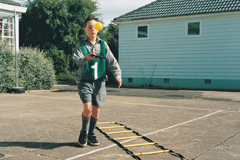![]() CHILDREN'S
CONSTRUCTION OF ‘HEALTH’ AND ‘FITNESS’
CHILDREN'S
CONSTRUCTION OF ‘HEALTH’ AND ‘FITNESS’
![]()
Lisette Burrows, Jan Wright
and Justine Jungersen-Smith
School-children
are both constructed by and construct their own notions and practices
of health and fitness on the basis of what they see around them.
This study examined the beliefs, knowledge and attitudes that
Year 4 and Year 8 students expressed about these concepts in the
1999 NEMP assessment of the health and physical education learning
area. |
All
results from Year 4 and Year 8 tasks that addressed students’ understandings
about health and fitness were collated and analysed using the NUD.IST
qualitative software package. Recurrent themes were identified and students’
responses analysed in relation to messages about health and fitness expressed
in the media and school-based and government health and physical education
resources. The institutional and cultural sets of ideas that may contribute
to children’s understandings about health and/or fitness were also
examined.
| •
Many students equated ‘being healthy’ with ‘being
fit’, and being fit with ‘looking good’. • The majority of students at both year levels equated fitness with ‘non-fatness’. • Year 8 students offered more holistic, expanded understandings than did Year 4 students, and were more aware of the consequences of specific behaviours on health and fitness. • Being healthy’ for the majority of students meant eating ‘right’, being clean, not smoking and not being overweight. • Being ‘fit’ for the majority of students meant being able to run, ‘not being fat’ and having a ‘better life’. • Some coherence between the imperatives of health and physical education in the New Zealand Curriculum statement and students’ responses was evident. Many students, particularly at Year 8, mentioned mental, social, spiritual and environmental constituents of ‘wellbeing’ together with physical elements of health. |
•
Most students regarded health and fitness as states of being that
are dependent on ‘the individual’. |
![]()
| •
Although knowledge about ‘health’ and ‘fitness’
is changing rapidly, students regard routes towards achieving these
states as fixed and certain. Students need to develop a critical capacity
to evaluate the health and fitness messages they receive from media,
school-based resources and government sources. • Despite the emphases of the Health and Physical Education Curriculum, many students continue to understand health and fitness as matters primarily concerned with the ‘physical body’ rather than connected to culture, social environment, relatedness with others and so on. |
•
Outside-school resources like those offered by ‘Life Education’
and the ‘Heart Foundation’ seem to be influencing students’
understandings about health and fitness. Given that these represent
just one way of thinking about these concepts, students need exposure
to alternative views about them. • Students’ equation of fitness with ‘not being fat’ is particularly worrying. Contemporary concerns about ‘eating disorders’, ‘body image’ and media advertising linking the ‘good life’ with ‘being slim’ make it imperative that students have opportunities to critically appraise the ‘accepted’ notion that ‘health/fitness’ means ‘slimness’. |
